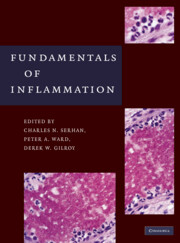Book contents
- Frontmatter
- Contents
- Contributors
- Preface
- PART I THE INFLAMMATORY RESPONSE – AN OVERVIEW
- PART II INDIVIDUAL CELL TYPES
- PART III CHEMICAL MEDIATORS
- PART IV IMMUNOPHARMACOLOGY
- PART V INFLAMMATORY DISEASES/HISTOLOGY
- PART VI ANIMAL MODELS OF INFLAMMATION
- 27 Models of Acute Inflammation – Air-Pouch, Peritonitis, and Ischemia-Reperfusion
- 28A Experimental Models of Glomerulonephritis
- 28B Glomerulonephritis and Ischemia Reperfusion Injury
- 29 Asthma
- 30 Animal Models of Rheumatoid Arthritis
- 31 Ocular Inflammation Models
- 32 Atherosclerosis in Experimental Animal Models
- 33 Oral Inflammation and Periodontitis
- 34 Pathogens and Inflammation
- Index
- References
31 - Ocular Inflammation Models
from PART VI - ANIMAL MODELS OF INFLAMMATION
Published online by Cambridge University Press: 05 April 2014
- Frontmatter
- Contents
- Contributors
- Preface
- PART I THE INFLAMMATORY RESPONSE – AN OVERVIEW
- PART II INDIVIDUAL CELL TYPES
- PART III CHEMICAL MEDIATORS
- PART IV IMMUNOPHARMACOLOGY
- PART V INFLAMMATORY DISEASES/HISTOLOGY
- PART VI ANIMAL MODELS OF INFLAMMATION
- 27 Models of Acute Inflammation – Air-Pouch, Peritonitis, and Ischemia-Reperfusion
- 28A Experimental Models of Glomerulonephritis
- 28B Glomerulonephritis and Ischemia Reperfusion Injury
- 29 Asthma
- 30 Animal Models of Rheumatoid Arthritis
- 31 Ocular Inflammation Models
- 32 Atherosclerosis in Experimental Animal Models
- 33 Oral Inflammation and Periodontitis
- 34 Pathogens and Inflammation
- Index
- References
Summary
INTRODUCTION
The eye is one of the primary sense organs. This unique organ is composed of highly specialized tissues: an outgrowth of the central nervous system, the retina, on the posterior end and a highly modified transparent skin, the cornea, on the anterior end (Figure 31.1). In the simplest terms, the primary function of the eye is to convert light energy into nerve action potentials. This essential and evolutionarily conserved function directly depends on maintaining (1) the refractive properties of the cornea, lens, aqueous humor, and vitreous humor; (2) formation and reabsorption of fluids that keep intraocular pressure in the fluid-filled eyeball constant; and (3) the function of retinal neurons. The eye, as an organ that faces the external environment, provides a unique opportunity to directly access highly specialized and diverse tissues such as the immune-privileged avascular cornea and the conjunctiva, a mucosal tissue that directs host defense and immune response of the ocular surface. Moreover, since light has to pass through the eye, physiological processes and cells in the anterior (cornea), interior (lens, uvea), and posterior (neural and vascular retinal layers) tissues of the eye (Figure 31.1) can be studied by noninvasive procedures in animals and humans [1 – 7].
The visual axis is a delicate sensory organ that has to maintain an avascular and transparent state in order to preserve ocular function. Hence, in the eye, especially in the cornea and retina, the threat of inflammation is incompatible with good vision.
- Type
- Chapter
- Information
- Fundamentals of Inflammation , pp. 413 - 426Publisher: Cambridge University PressPrint publication year: 2010
References
- 1
- Cited by



